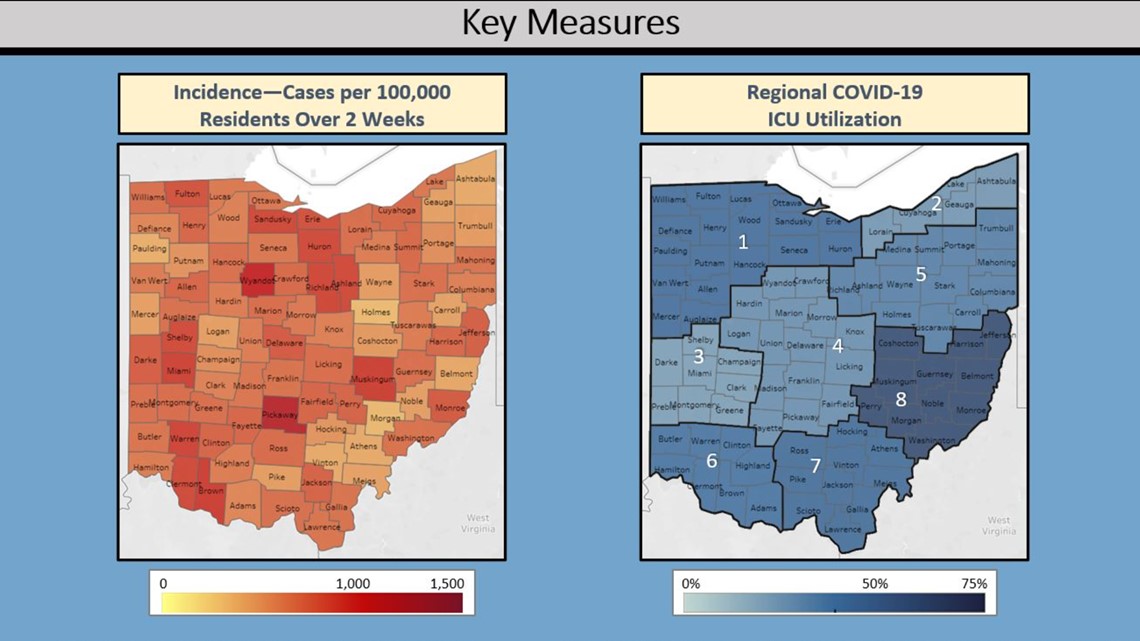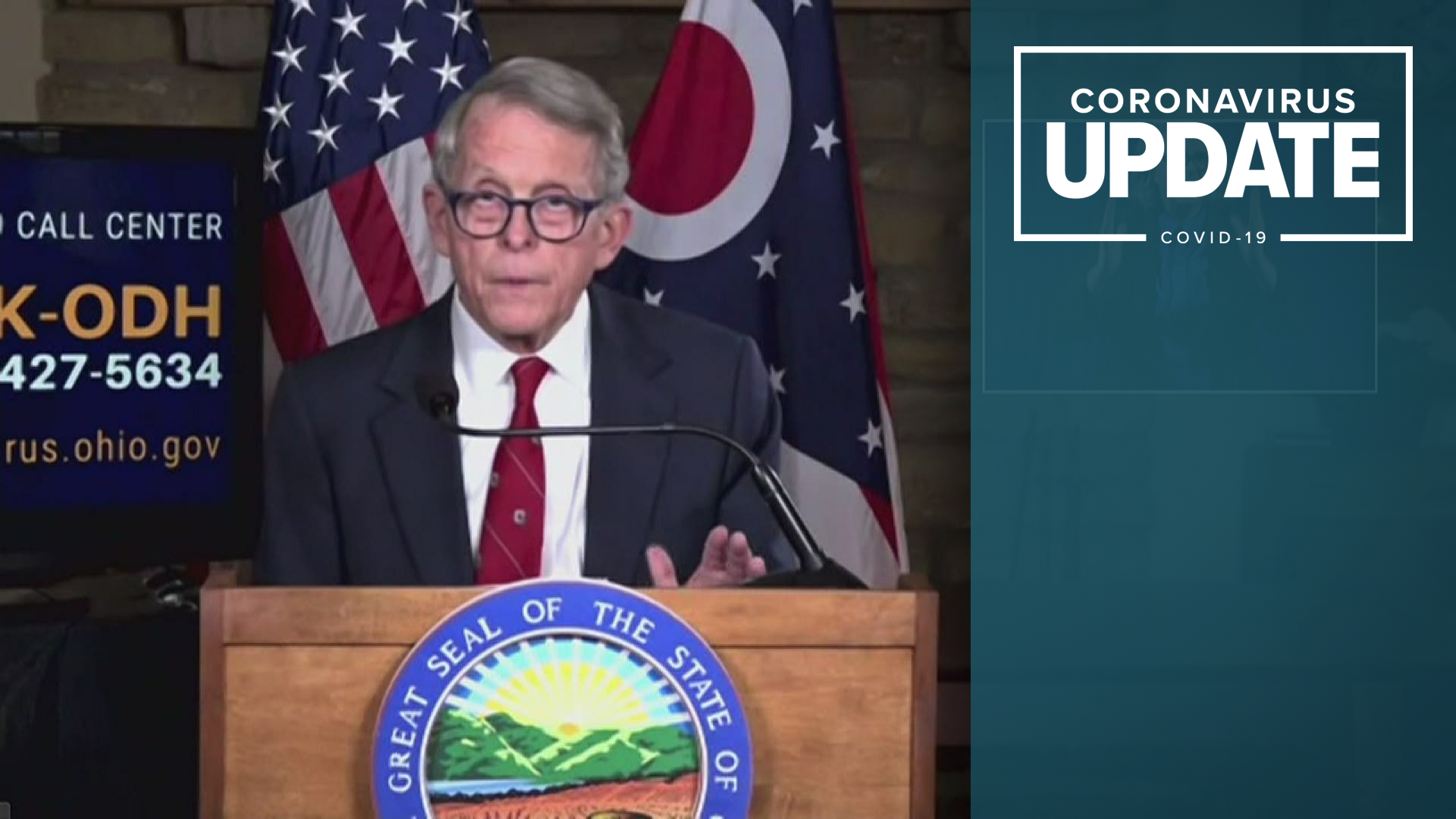COLUMBUS, Ohio — Gov. Mike DeWine addressed Ohioans on Wednesday, extending the statewide curfew and adjusting school quarantine guidelines, as the state's vaccination effort continues.
Here is a breakdown of what was discussed.
STATEWIDE CURFEW
Ohio's curfew has been extended for another three weeks, with the new end date set for Jan. 23, 2021.
The curfew lasts from 10 p.m. - 5 a.m. nightly, with the goal of limiting unneccessary travel. However, there are a number of exceptions, including:
- Going to or from work
- Leaving for an emergency or to receive medical care.
- Getting groceries
- Going to the pharmacy
- Picking up food
Drive-thrus, takeout options and delivery have also been able to continue during the curfew period, however, indoor dining is still required to close at 10 p.m.
The governor said the extension was put into place as health leaders still don't know what effects the holidays could have on the state's hospitals.
"We must continue to be cautious," he said.
VACCINE
Here are the expected doses of the COVID-19 vaccine coming to Ohio next week:
- Moderna - 69,500
- Pfizer (first dose) - 72,200
- Pfizer (second dose) - 98,475.
DeWine said Wednesday that so far, 94,078 Ohioans have received the vaccine.
The governor encouraged everyone who is given the opportunity to get the vaccine to take it, as long as they don't have a medical reason not to do so.
For those especially in the early stages of the vaccination process, he cautioned that if the vaccine is turned down, it is unclear when another opportunity to receive the shot will arise.
While the goal is to ultimately offer the shot to everyone in Ohio, DeWine said that process will likely span across several months.
"It is a lifesaver. We will never know of those people who get the vaccine, whose lives will be saved. But we do know many, many lives will be saved," DeWine said.
Walgreens and CVS are vaccinating in nursing homes, while hospitals are continuing to vaccinate their staff.
As local health departments conduct contact tracing, they are working involved in the vaccination process, including giving shots to EMS personnel and Ohioans within some congregate care facilities.
DeWine Wednesday, called on hospitals to do everything within their power to get their vaccine doses out within 24 hours. After those doses are administered, the goal is to then have them reported to the state within another 24-hour period. However, he noted this won't always be possible.
SCHOOLS
Earlier this year, the governor pledged to look at the rate of COVID-19 transmission within Ohio's schools. Preliminary results from the Ohio Schools COVID-19 Evaluation Team found that if students in class are masked and properly distanced, they did not have an increased risk of catching the virus from a nearby positive student.
In response to the team's findings, the state has changed its guidance, and is no longer recommending that students who have been exposed to another COVID-19 positive student quarantine - as long as all students have been wearing masks and if the exposure happened in a classroom setting.
Schools should continue to quarantine exposed students if masking and distancing protocols were not followed, however. DeWine said the change doesn’t apply to after-school activities, including sports.
ODH Chief Medical Officer Dr. Bruce Vanderhoff said that in Ohio, a pool of 728 students in seven school districts were tested between Nov. 10 - Dec. 18.
Among those students were 524 who, while in classroom, were noted to be in close contact with someone COVID-19. The other students in the study were either in the same classroom, but further away or were outside of the classroom, but in the same grade.
The study found that there was no discernable difference in incidence rate among the exposed students and those who were not exposed. Both groups had an incidence rate around 3%.
Vanderhoff emphasized the fact, however, that these students were in classroom settings, not extracurricular, community or home.
A Mississippi report supports Ohio's data, showing close contacts of children with COVID-19 were more likely to be family members and less likely to be classmates. Attending school in-person, or two weeks before getting tested, was not associated with an increased likelihood of a positive COVID-19 test.
"Our schools have been doing a tremendous job of implementing robust safety measures. When they're applied daily across the state, our schools represent the safest place for most of our students," Vanderhoff said. "When you couple this with the fact that teachers and other staff will soon be eligible to recieve the COVID-19 vaccine, we really beleive we have a solid package."
KEY INDICATORS
On Wednesday, the Ohio Department of Health reported:
- 8,178 new cases of COVID-19 compared to the 21-day average of 8,126
- 133 new deaths compared to the 21-day average of 79
- 366 new hospitalizations compared to the 21-day average of 348
- 36 new ICU admissions compared to the 21-day average of 37


CASES PER 100,000
In northwest Ohio, there were five counties in the top 20 of DeWine's list of those with the most cases per 100,000 to the least, including:
- Wyandot with 1,015.1 cases per 100,000
- Sandusky with 854.4 cases per 100,000
- Huron with 846.1 cases per 100,000
- Erie with 813.3 cases per 100,000
- Fulton with 802.4 cases per 100,000
The CDC's threshold for high incidence is 100 cases per 100,000 people. Every Ohio county is now at least three times the CDC limit.


KEY MEASURE MAPS
All regions of the state have at least 1/5 of their ICU patients who are positive for COVID-19. In most of the regions, 1/3 or more patients in the ICU are COVID-19 positive.


FULL PRESS CONFERENCE
You can re-watch DeWine's full press conference in the player below.

